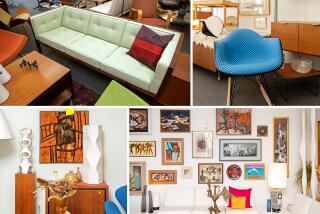New Store Chain Is Hoping Everyone Will Feel at Home
CORTE MADERA, Calif. — “Did you see them?” asked Dave DeMattei, Williams-Sonoma’s president of emerging brands, gesturing animatedly to a couple in their 60s strolling through his company’s West Elm store here, just north of San Francisco.
“They’re a very fashionable couple. She has Prada shoes on,” he whispered.
The shoppers were just the sort that West Elm seeks, DeMattei said, in its efforts to develop “a modern aesthetic for the masses.” To the 48-year-old executive, they show that the chain, originally aimed at futon owners in their 20s and 30s, is finding a way to appeal to a much broader range of customers.
Indeed, DeMattei and Howard Lester, chairman of San Francisco-based Williams-Sonoma Inc., are so sure of tiny West Elm that they are betting it will one day be the company’s biggest brand, with more locations than its 253 namesake epicurean stores and the 183-store Pottery Barn home decor chain.
They’ve got a long way to go. For starters, with about $30 million in sales last year through its six stores, catalog and online business, West Elm generated just 1% of Williams-Sonoma’s total revenue, investment firm SG Cowen & Co. estimates.
West Elm’s mix of modular seating, geometric bookcases and low platform beds also is far less mainstream than the homey, slip-covered, overstuffed fare that generated an estimated $1.4 billion in 2004 sales at Pottery Barn.
But with the pace of new-store openings slowing with its two big brands, WilliamsSonoma needs West Elm to provide a growth vehicle in the years ahead, analysts say -- just as Old Navy brought dramatic growth to DeMattei’s former employer Gap Inc.
So far, the numbers look promising.
Of the handful of West Elm locations now open, most are in the top 10% by sales volume of all of Williams-Sonoma’s stores. West Elm’s location in the Chelsea district of New York is the highest-grossing store in the retailer’s entire portfolio.
“For a brand-new brand, that’s pretty significant,” DeMattei said.
And it’s noteworthy, given that with West Elm, “no one knows it’s Williams-Sonoma behind it,” SG Cowen analyst Lauren Levitan said.
“All of the other brands launched recently have been the siblings of a brand that’s well known already,” she said, referring to PBteen and the company’s newest venture, the upscale Williams-Sonoma Home.
Indeed, West Elm is doing so well, Levitan said, that Williams-Sonoma is expected to accelerate the number of store openings in 2006 after opening five this year.
“Given the lead times on real estate and finding appropriate locations, we think that this is a pretty aggressive rollout,” she said.
Parent Williams-Sonoma, which will celebrate its 50th anniversary next year, long ago moved out of the kitchen and further into customers’ homes, acquiring Pottery Barn in 1986 and building other home furnishings brands through catalog and online sales.
The company launched West Elm in 2002 and then followed its well-established catalog-to-brick-and-mortar tradition in fall 2003 when it opened a store in Brooklyn.
West Elm is scheduled to expand this year to 4th Street in Santa Monica -- the third store in California, after those in Corte Madera and San Diego -- as well as to Atlanta, Houston, Washington and Princeton, N.J.
DeMattei, who made his name heading fast-growing retailers such as Banana Republic, J. Crew and Coach, was brought in two years ago to help broaden the appeal of West Elm and build it into a chain that could rival Pottery Barn.
The challenge, said analyst Kristine Koerber of JMP Securities in San Francisco, will be to show that West Elm will play beyond the loft districts of Manhattan and San Francisco.
“It seems to work in urban markets, but will it play in Boise?” she said.
DeMattei said the chain had already proved itself in suburban markets, such as Oakbrook, Ill.
“The bestsellers are the bestsellers in every store,” he said, referring to such items as $99 hippie shell chandeliers, $299 Moroccan headboards and $29 sequined throw pillows.
West Elm’s stores, regardless of location, look like lofts, with exposed brick walls and recycled-wood floors; the sales staff is dressed in all black. As at rival IKEA, rooms in the store are arranged on small platforms, or “apartments,” with merchandise on surrounding shelves. All of West Elm’s furniture, even bed frames and couches, is stored in the back room, so customers can drive off with their purchases that day rather than wait for them to be shipped.
“We think that a piece of the market that’s underserved is modern-looking furniture that is of good quality that doesn’t break the bank,” DeMattei said.
Indeed, while the overall furniture and home decor market has boomed in recent years, rising along with home sales, analysts say there have been few affordable options for customers looking to trade up from IKEA or Target, save for struggling retailer Pier 1 Imports Inc.
“They have clearly identified an underserved market and figured out how to serve that customer,” Levitan said.
Williams-Sonoma isn’t the only one rushing to fill that niche.
Restoration Hardware Inc., based a couple of miles from West Elm’s Corte Madera store, recently hired West Elm creator Lisa Versacio, who left two years ago. Restoration plans to launch a new home decor catalog as early as next year, the company said.
Others are more skeptical of West Elm’s potential.
“They have great color and great ideas,” said Bette Kahn, a spokeswoman for rival Crate & Barrel, a unit of Euromarket Designs Inc. of Northbrook, Ill. “But they have just one look,” she said, and one that doesn’t necessarily mix well with other styles of furniture.
DeMattei acknowledged that West Elm needed tweaking when he arrived to succeed Versacio.
“At the beginning, it was pretty edgy,” he said. “It was all purple and green in color palette.... People couldn’t picture it in their homes.”
His influence is beginning to be seen in the company’s goods. In addition to broadening the palette, he has worked with the chain’s designers to make some of its low furniture sit higher, to offer pieces in light wood as well as its trademark chocolate and to upgrade the quality of fabrics and the thread count of sheets.
DeMattei is trying to sell a lifestyle rather than individual products and loves being able to start trends, he said.
“The great thing about specialty retailing,” he said, “is we have a point of view.... We get to tell the customer what’s important.”
But selling West Elm to everyone could prove difficult.
John Calella, 60, one of the two shoppers DeMattei spotted in Corte Madera, said that he was intrigued by West Elm’s bright, airy stores and modern furniture but that he was unsure how much he would actually buy.
“This is a beautiful design,” he said, eyeing a low-slung coffee table. But, he said, he was unsure about the quality and afraid “that in two or three years it will go out of style.”
Calella left the store empty-handed.
Shopper Jeannette Pedroni, however, believes that West Elm has plenty of staying power.
“It’s simple and stylish. And it’s got great music,” said the San Francisco flight attendant. “It’s kind of like a lower-priced Pottery Barn.”
More to Read
Inside the business of entertainment
The Wide Shot brings you news, analysis and insights on everything from streaming wars to production — and what it all means for the future.
You may occasionally receive promotional content from the Los Angeles Times.










